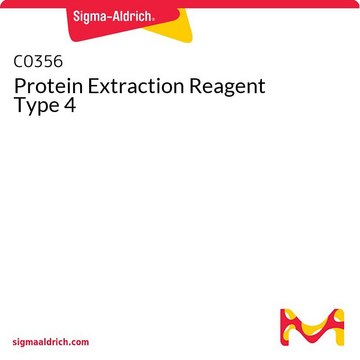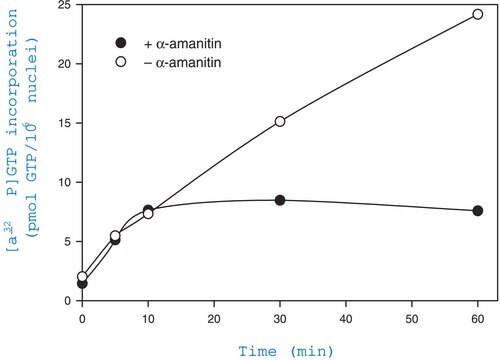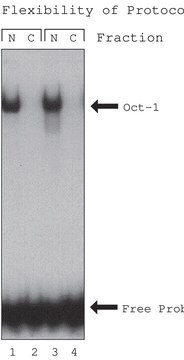PE0240
Plant Fractionated Protein Extraction Kit
Suitable for any plant species or tissue
Sign Into View Organizational & Contract Pricing
All Photos(1)
About This Item
UNSPSC Code:
41105500
NACRES:
NA.56
Recommended Products
usage
sufficient for 20 extractions
storage temp.
−20°C
General description
Sigma′s Plant Fractionated Protein Extraction Kit is designed specifically for use in plant bioscience to extract qualitative hydrophilic and hydrophobic proteins samples from any type of plant species or tissue for downstream proteomic applications. The protocol does not require any ultracentrifugation or aqueous polymer two-phase partitioning (APTP). The kit includes five reagents; a plant specific protease inhibitor, a specially formulated reagent to extract hydrophilic proteins and a new chaotropic reagent with increased solubilizing power to extract more hydrophobic proteins. Also included in the kit are reducing reagent Tributylphosphine (TBP) and alkylating reagent, Iodoacetamide. These reagents improve separation during isoelectric focusing and 2-D gel electrophoresis. The protease inhibitor is a mixture of protease inhibitors with broad specificity for the inhibition of serine, cysteine, aspartic, metalloproteases and aminopeptidases. The cocktail contains 4-(2-aminoethyl)benzenesulfonyl fluoride (AEBSF), bestatin, pepstatinA, E-64, leupeptin, and 1,10-phenanthroline.
Following removal of polyphenolics, tannins and other interfering substances, ground plant tissue, fresh or frozen, is resuspended in a specially formulated reagent to extract hydrophilic proteins. After sequential extractions of hydrophilic proteins, addition of the chaotropic reagent provided extracts hydrophobic membrane bound proteins. Plant debris is pelleted by centrifugation and protein extract solutions are collected. The end results are qualitative fractionated protein samples, ready for downstream proteomic analysis.
Following removal of polyphenolics, tannins and other interfering substances, ground plant tissue, fresh or frozen, is resuspended in a specially formulated reagent to extract hydrophilic proteins. After sequential extractions of hydrophilic proteins, addition of the chaotropic reagent provided extracts hydrophobic membrane bound proteins. Plant debris is pelleted by centrifugation and protein extract solutions are collected. The end results are qualitative fractionated protein samples, ready for downstream proteomic analysis.
Kit Components Also Available Separately
Product No.
Description
SDS
- Plant Protein Extraction Reagent Type 1 1 bottle
- C0356Protein Extraction Reagent Type 4 1 bottleSDS
- P9599Protease Inhibitor Cocktail, for plant cell and tissue extracts, DMSO solution 3 x 1SDS
- T7567Tributylphosphine solution, 200 mM (in N-methyl-2-pyrrolidinone), liquid 3 x 0.5SDS
- A3221Iodoacetamide, Single use vial of 56 mg 3 vial(s)SDS
Signal Word
Danger
Hazard Statements
Precautionary Statements
Hazard Classifications
Acute Tox. 3 Oral - Aquatic Chronic 2 - Carc. 2 - Eye Dam. 1 - Repr. 1B - Resp. Sens. 1 - Skin Corr. 1A - Skin Sens. 1 - STOT SE 3
Target Organs
Respiratory system
Storage Class Code
6.1C - Combustible acute toxic Cat.3 / toxic compounds or compounds which causing chronic effects
Certificates of Analysis (COA)
Search for Certificates of Analysis (COA) by entering the products Lot/Batch Number. Lot and Batch Numbers can be found on a product’s label following the words ‘Lot’ or ‘Batch’.
Already Own This Product?
Find documentation for the products that you have recently purchased in the Document Library.
Customers Also Viewed
M Ferro et al.
Electrophoresis, 21(16), 3517-3526 (2000-11-18)
As a complementary approach to genome projects, proteomic analyses have been set up to identify new gene products. One of the major challenges in proteomics concerns membrane proteins, especially the minor ones. A procedure based on the differential extraction of
Loomis, W.D.
Methods in Enzymology, 31, 528-545 null
Wenhao Yue et al.
The Plant journal : for cell and molecular biology, 90(6), 1040-1051 (2017-02-24)
Inorganic phosphate (Pi) transporters (PTs) play vital roles in Pi uptake and translocation in plants. Under Pi sufficient conditions, PTs are degraded to prevent excess Pi accumulation. The mechanisms targeting PTs for degradation are not fully elucidated. In this study
Siew-Yong Koay et al.
Journal of chromatography. B, Analytical technologies in the biomedical and life sciences, 879(22), 2179-2183 (2011-06-22)
Orthosiphon aristatus is a traditionally used medicinal plant. In order to study the proteome of the plant, we have developed a simple plant protein extraction method by direct extraction of protein using a modified 2D-gel compatible tris-sucrose buffer followed by
Angus L Dawe et al.
Methods in molecular biology (Clifton, N.J.), 722, 225-236 (2011-05-19)
The interaction of the filamentous fungal plant pathogen Cryphonectria parasitica with its virulence-attenuating viruses provides a unique platform to explore the molecular biology and genetics of virus-host interactions. Following the development of transformation procedures for this fungus, subsequent advances include
Our team of scientists has experience in all areas of research including Life Science, Material Science, Chemical Synthesis, Chromatography, Analytical and many others.
Contact Technical Service














